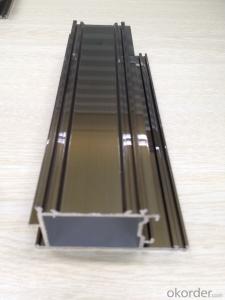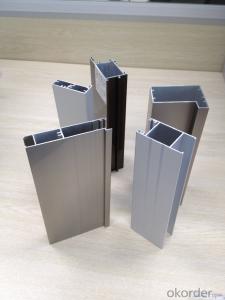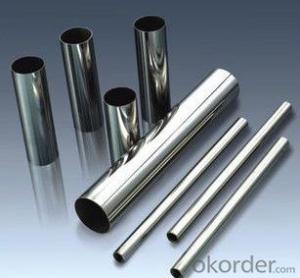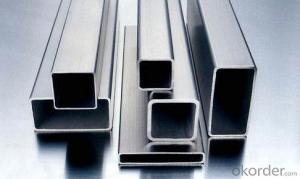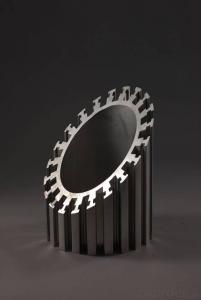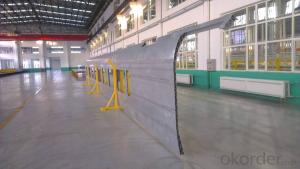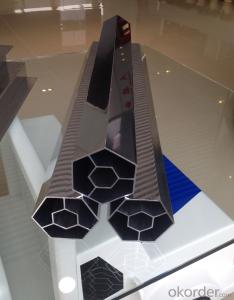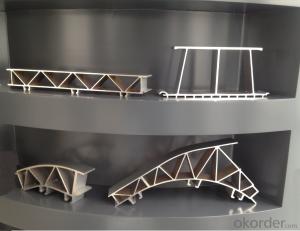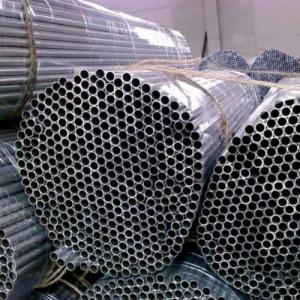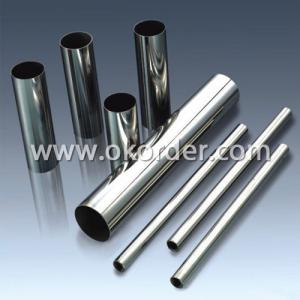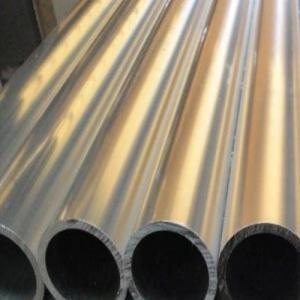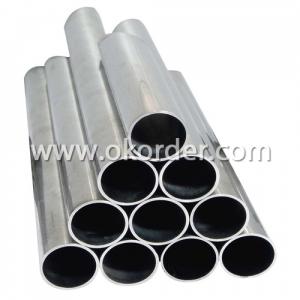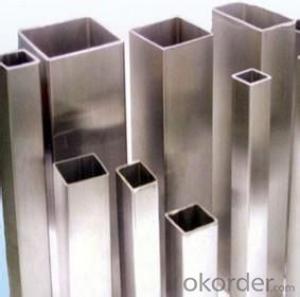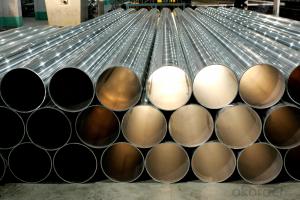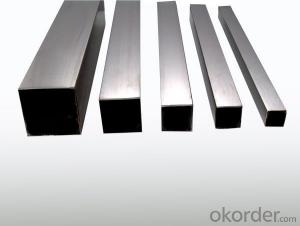Aluminum profile for building material
OKorder Service Pledge
OKorder Financial Service
You Might Also Like
We are the largest aluminum profilemanufacture in
Material | Alloy Aluminum 6063,6061,6005,6082 or customer nominated |
Temper | T3, T4, T5, T6 and other |
Surface | Anodize, electrophoresis, powder coating, PVDF coating, wood grain painting, etc. |
Colour | Any colour based on Standard Germany RAL Mark |
Length | Not more than 16 meters |
Good Package | Inner plastic film /outside carton/wooden pallets |
Payment Method | T/T, L/C, etc |
Delivery Time | Normally 2-4 weeks, Delivery time can be consulted. |
Press Machine | 500-12500 tons all together 93 press lines. |
Fabrication | 1. Furniture;2. Drilling; 3. Bending; 4. Cutting; 5. Windows and doors;6.etc. |
Certificate | ISO/TS 16949,DNV,IRIS,CCS,AFA,etc. |
Dies | 1. Using our dies, no fee; |
2. Using customer drawing, opening dies, usually about 5~50 tons then the dies cost can be refunded. | |
3. Die cost is negotiable base on the order quantity | |
Capability | Annual output 800,000 tons |
- Q:What's the good quality of the aluminum tubes used for air conditioning?
- 1. pure copper has excellent ductilityAir conditioning has a tube expanding process in the manufacturing process, is put through the fin copper pipe burst, let bobbin and fin precision contact tube expanding technology is the key performance of heat exchanger of air conditioning, the ductility of copper to ensure good not easy in this process is broken.2. copper has an unparalleled corrosion resistanceCopper is much more resistant to corrosion than aluminum in the outdoor hostile environment. Statue of Liberty has been thinned since 1886 for more than 120 years, and that is proof of 0.127mm.4. in the joint place with copper and aluminum composite, two kinds of metal binding sites are likely to occur electrochemical corrosion potential of copper is +0.34V standard, standard potential of aluminum -1.28V, the potential difference between copper and aluminum is +1.62V. If direct contact between copper and aluminum, water in the air and carbon monoxide and other harmful impurities will form electrolyte on the contact surface of the joint, causing electrochemical corrosion, which is called galvanic cell.
- Q:Are aluminum pipes fire-resistant?
- Yes, aluminum pipes are generally considered to be fire-resistant. Aluminum has a high melting point of 660 degrees Celsius (1220 degrees Fahrenheit) and does not burn easily. Additionally, aluminum forms a protective oxide layer on its surface when exposed to oxygen, which helps prevent further combustion. These characteristics make aluminum pipes a suitable choice for applications that require fire resistance, such as in industrial settings or for the transport of flammable substances. However, it is important to note that while aluminum pipes may be fire-resistant, they can still transfer heat and conduct electricity, so proper precautions and insulation should be taken when using them in potentially hazardous environments.
- Q:Can aluminum pipes be used for hydraulic systems?
- Indeed, hydraulic systems can utilize aluminum pipes. Aluminum, being a lightweight and corrosion-resistant substance, proves to be a fitting option for a wide range of applications, including hydraulic systems. Aluminum pipes bring forth benefits such as effortless installation, a remarkable strength-to-weight ratio, and exceptional resistance against rust and corrosion. Nevertheless, it is crucial to take into account the operational pressure and temperature prerequisites of the hydraulic system, as aluminum pipes may have limitations in high-pressure or high-temperature scenarios when compared to materials like steel. Consequently, it is advisable to seek guidance from a hydraulic system specialist or engineer, who can aid in determining the most suitable material for your specific hydraulic system demands.
- Q:Can aluminum pipes be used for wastewater disinfection systems?
- Indeed, wastewater disinfection systems can utilize aluminum pipes. Aluminum, a versatile and durable material, finds extensive application in various industries, including wastewater treatment. It boasts numerous advantages for disinfection systems, such as resistance to corrosion, lightweight composition, and ease of installation. Aluminum pipes exhibit remarkable resistance to corrosion, rendering them suitable for handling wastewater potentially containing harsh chemicals or corrosive substances. They can endure the corrosive impact of wastewater for prolonged periods without deterioration or demanding frequent maintenance. Furthermore, aluminum pipes are lightweight and easily manageable, making them highly convenient for installation in wastewater treatment plants. Their low weight not only reduces transportation costs but also simplifies the overall construction process. Moreover, aluminum pipes are compatible with different disinfection methods commonly employed in wastewater treatment, such as chlorination and UV disinfection. They efficiently direct disinfection agents or UV light throughout the system, ensuring effective disinfection of wastewater. However, it is essential to note that aluminum pipes may not be suitable for all wastewater disinfection systems. Certain specific disinfection methods, like ozonation, may not be compatible with aluminum due to potential reactions. In such scenarios, alternative materials like stainless steel might prove more appropriate. To summarize, aluminum pipes offer excellent corrosion resistance, lightweight composition, and ease of installation, making them a viable option for wastewater disinfection systems. Nevertheless, it is crucial to consider the specific disinfection method and its compatibility with aluminum before selecting it as the material for the system.
- Q:Is GREE a brass tube or an aluminum tube?
- Air conditioning heat exchange tube is the use of pure copper is not soft aluminum tubes could not resist exposure and alternating hot and cold days and months multiplying each business even in order to reduce the cost is not used because of the short service life of aluminum tubes and easy deformation of the head down business costs high maintenance rate is lost in their own businesses after all is said and done. Copper is only copper content more with less
- Q:What are the advantages of using aluminum pipes?
- Aluminum pipes have gained popularity in various industries and applications due to their numerous advantages. Firstly, their lightweight nature makes them easy to handle and transport, which is particularly beneficial in industries like automotive and aerospace where reducing weight is crucial for fuel efficiency and performance. Furthermore, the lightweight characteristic of aluminum pipes simplifies installation and requires less effort for maintenance or repairs. Secondly, aluminum pipes possess excellent corrosion resistance. They naturally develop a protective oxide layer on their surface, preventing rusting or deterioration in harsh environments. This corrosion resistance makes aluminum pipes ideal for applications exposed to moisture, chemicals, or extreme temperatures, such as plumbing, HVAC systems, and marine applications. Another advantage of aluminum pipes is their high thermal conductivity. With their excellent heat conduction ability, aluminum pipes facilitate efficient heat transfer. This attribute makes them suitable for applications where heat dissipation is critical, such as heat exchangers and radiators. Furthermore, aluminum pipes are highly durable and boast a long lifespan. They have a high strength-to-weight ratio, which means they can withstand pressure and stress while remaining lightweight. This durability translates to cost-effectiveness as they require fewer replacements or repairs over time. Lastly, aluminum pipes contribute to environmental friendliness. Aluminum is a highly recyclable material, and recycling it consumes only a fraction of the energy required for producing new aluminum. Opting for aluminum pipes promotes sustainable practices and minimizes the overall carbon footprint. In conclusion, the advantages of aluminum pipes encompass their lightweight nature, corrosion resistance, high thermal conductivity, durability, and environmental friendliness. These qualities establish aluminum pipes as a versatile and dependable choice for various industries and applications.
- Q:Can aluminum pipes be bent or shaped?
- Yes, aluminum pipes can be bent or shaped. Aluminum is a malleable metal, meaning it can be easily formed into different shapes without breaking. There are various methods available to bend or shape aluminum pipes, such as using a pipe bender, heat bending, or hydraulic press. The specific technique used will depend on the desired shape and the thickness of the aluminum pipe. It is important to note that the bending or shaping process should be done carefully to avoid damaging the pipe or causing any structural weaknesses.
- Q:Are aluminum pipes suitable for automotive exhaust systems?
- Automotive exhaust systems can indeed utilize aluminum pipes. Aluminum, being both lightweight and durable, possesses numerous advantages for exhaust systems. To begin with, aluminum pipes exhibit resistance to corrosion, a critical characteristic for an automotive exhaust system exposed to heat, moisture, and various chemicals. This resistance to corrosion aids in extending the lifespan of the exhaust system and ensures its proper functionality over an extended period. Moreover, aluminum pipes possess exceptional heat dissipation properties. Thanks to aluminum's high thermal conductivity, it can rapidly dissipate the heat generated by exhaust gases, thereby preventing overheating and potential harm to other vehicle components. This becomes especially crucial in high-performance vehicles, where exhaust temperatures can rise significantly. Furthermore, aluminum pipes are relatively easy to manipulate and can be shaped and sized in various ways, making them versatile for different vehicle applications. Their lightweight nature also contributes to enhanced fuel efficiency and reduced overall vehicle weight, both of which can have a positive impact on performance. However, it is important to note that aluminum pipes may not be suitable for every automotive exhaust system. In situations where extreme temperatures or excessive vibrations are expected, alternative materials like stainless steel or titanium may be more appropriate. Nevertheless, for most standard to moderately high-performance vehicles, aluminum pipes represent a suitable and cost-effective choice for automotive exhaust systems.
- Q:Can aluminum pipes be used for heat transfer applications?
- Yes, aluminum pipes can be used for heat transfer applications. Aluminum has excellent thermal conductivity, which means it can efficiently transfer heat from one area to another. This makes aluminum pipes ideal for applications where heat needs to be transferred or dissipated, such as in HVAC systems, heat exchangers, radiators, and air conditioning units. Additionally, aluminum pipes are lightweight, corrosion-resistant, and cost-effective, making them a popular choice in many industries.
- Q:What is the difference between water conditioned copper tubes and aluminum tubes?
- From the price point of view, the aluminum tube is much cheaper than copper; from the heat transfer effect, the copper tube is better than the aluminum tube; from the quality, the copper tube is more durable than the aluminum tube, and the service life is long. In a word, copper tubes are better than aluminium tubes
1. Manufacturer Overview |
|
|---|---|
| Location | |
| Year Established | |
| Annual Output Value | |
| Main Markets | |
| Company Certifications | |
2. Manufacturer Certificates |
|
|---|---|
| a) Certification Name | |
| Range | |
| Reference | |
| Validity Period | |
3. Manufacturer Capability |
|
|---|---|
| a)Trade Capacity | |
| Nearest Port | |
| Export Percentage | |
| No.of Employees in Trade Department | |
| Language Spoken: | |
| b)Factory Information | |
| Factory Size: | |
| No. of Production Lines | |
| Contract Manufacturing | |
| Product Price Range | |
Send your message to us
Aluminum profile for building material
OKorder Service Pledge
OKorder Financial Service
Similar products
New products
Hot products
Hot Searches
Related keywords
